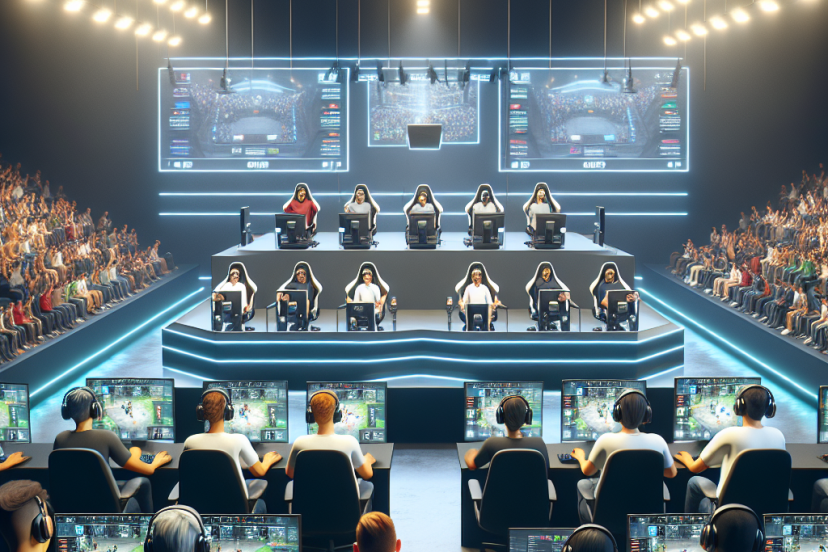Improving Your Game: The Top Monitors for Competitive Play
Understanding Monitor Specifications for Competitive Gaming
When selecting the ultimate gaming monitor, competitive players must prioritize specifications that enhance their gameplay experience. Key specifications include refresh rate, response time, resolution, and panel type.
-
Refresh Rate: A Game-Changer in Fluid Motion
The refresh rate, measured in Hertz (Hz), indicates how often a monitor updates its image each second. For competitive gaming, a higher refresh rate translates to smoother motion and increased responsiveness. Standard monitors typically provide 60Hz, but for competitive players, 144Hz is ideal, while 240Hz is becoming the gold standard for titles requiring rapid reaction times. -
Response Time: Immediate Feedback
Response time, measured in milliseconds (ms), refers to how quickly a pixel can change from one color to another. For competitive gaming, particularly in fast-paced genres like first-person shooters (FPS) or multiplayer online battle arenas (MOBA), a response time of 1ms to 3ms is optimal. Lower response times minimize ghosting effects, where trailing images appear during rapid motion—a common concern in high-stakes environments. -
Resolution: Clarity Over Clutter
While a higher resolution often enhances visual fidelity, balance is key when participating in competitive play. The most common resolution for competitive gaming is 1920×1080 (Full HD). It provides sufficient detail without compromising frame rates on most graphics cards. However, some players opt for 2560×1440 (QHD) monitors for sharper images and a wider field of view, provided their systems can handle the increased demand. -
Panel Types: Choosing Your View
The type of panel can significantly affect performance and visual output. Three main types dominate the market:-
Twisted Nematic (TN): Known for exceptional response times, TN panels are the preferred choice for competitive players due to their speed and lower costs. However, their color reproduction and viewing angles are not as strong as other types.
-
In-Plane Switching (IPS): IPS monitors provide vibrant colors and wide viewing angles, ideal for rich graphics in games. While their response times have improved, they generally lag slightly behind TN panels, making them less preferred for ultra-competitive settings.
-
Vertical Alignment (VA): VA panels offer better contrast ratios and colors than TN but can suffer from higher response times. They find favor among gamers who value visual quality, especially in role-playing games (RPGs) or strategy titles.
-
Top Competitive Gaming Monitors to Enhance Your Play
Now that the key specifications are clear, let’s delve into the top gaming monitors that epitomize excellence for competitive play:
-
ASUS ROG Swift PG259QN
The ASUS ROG Swift PG259QN is tailored for competitive gamers. Featuring a blistering 360Hz refresh rate and 1ms response time, it offers unparalleled clarity in high-speed scenarios. The G-Sync compatibility ensures choppy gameplay is minimized, providing a competitive edge during online sparring. With a 24.5-inch Full HD display, gamers enjoy sharp visuals without lag. -
Acer Predator XB273U GX
Ideal for players needing an IPS screen, the Acer Predator XB273U GX supports a 270Hz refresh rate and a 1ms response time. The combination of a stunning 2560×1440 resolution and G-Sync technology delivers both vibrancy and fluidity, making it perfect for fast-paced titles that demand quick reflexes while ensuring that all colors pop. -
Alienware AW2521H
Bridging the gap between style and performance, the Alienware AW2521H features a 360Hz refresh rate and 1ms response time. This 25-inch monitor is G-Sync certified, featuring a sleek design that accommodates a dynamic gaming setup. It also boasts HDR support, ensuring players can enjoy vibrant visuals even during high-stakes matches. -
LG UltraGear 27GN750
The LG UltraGear 27GN750 strikes a balance between performance and ease of use. With a 240Hz refresh rate and 1ms response time, it’s tailored for FPS and MOBA titles. The included FreeSync technology ensures a tear-free gaming experience. Its sleek design and vibrant color reproduction enhance any gaming environment, beckoning both casual and competitive players alike. -
ViewSonic XG2431
For gamers on a budget, the ViewSonic XG2431 offers quality without breaking the bank. With a 144Hz refresh rate and 1ms response time, it proves to be an excellent entry-level option. Despite its affordability, it still delivers on color quality and user-friendly features, making it perfect for newcomers looking to take their gaming to the next level.
Adjustments for Optimal Gaming Performance
While selecting the right monitor is crucial, adjustments to monitor settings can also drastically improve performance. Here are some tips:
-
Calibration: Players should calibrate their monitors for optimal color accuracy, especially if they switch between genres. Tools like Datacolor Spyder or X-Rite i1Display can assist in achieving precise color representation.
-
Overclocking: Some monitors, particularly those with high refresh rates, allow overclocking, boosting refresh rates beyond the factory settings. This can improve responsiveness, but caution is advised as it may shorten monitor lifespan.
-
Game Mode Settings: Many monitors come equipped with presets for gaming. These “Game Modes” adjust brightness, contrast, and response time to enhance gameplay, allowing players to switch settings quickly based on the type of game they’re playing.
Ergonomics and Build Quality
Beyond performance specifications, ergonomics and build quality play crucial roles in long gaming sessions. Monitors should have adjustable height, tilt, and pivot features to promote comfort and reduce the strain on players’ necks and eyes.
-
Adjustable Stands: A monitor with an adjustable stand allows for flexible positioning, promoting better posture during gameplay. Ergonomic setups can lead to higher concentrations during competitive play, reducing fatigue.
-
VESA Mount Compatibility: For players looking to customize their setups, VESA mount compatibility provides the freedom to mount the monitor on larger, more dynamic stands or walls, providing a clean, organized gaming environment.
-
Blue Light Filters: Extended exposure to screens can cause strain; many modern monitors include blue light filters to reduce eye discomfort during prolonged use. This capability is essential for competitive players involved in marathon gaming sessions.
In competitive gaming, utilizing the right tools can empower players to perform at their best. By understanding monitor specifications, selecting high-quality monitors, optimizing settings, and considering ergonomic factors, players can significantly enhance their gaming experiences and improve their overall performance on the battlefield.




